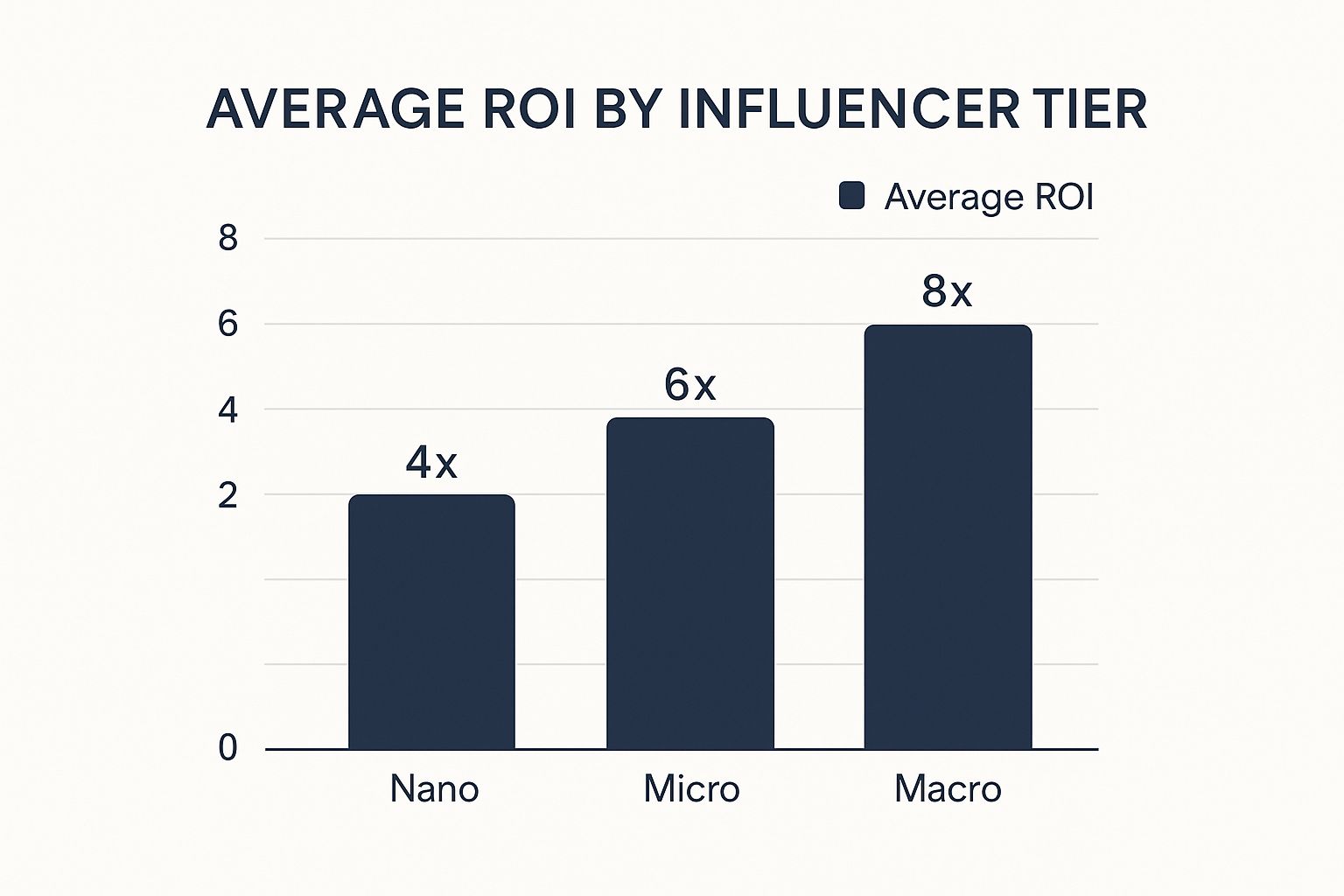Why Smart Startups Are Betting Everything On Influencer Marketing
The traditional marketing playbook is becoming outdated, often consuming budgets without delivering a satisfactory ROI. Forward-thinking startups are recognizing this change and embracing influencer marketing as a powerful strategy. It allows them to compete with larger, more established companies, all while maintaining a leaner budget. This approach facilitates authentic connections with their target demographic, building trust and brand loyalty that traditional methods often fail to achieve. This fosters a sense of community around the brand, encouraging not just initial purchases but also long-term customer retention.
The Power of Trust and Authenticity
Instead of impersonal advertisements, startups are using the pre-existing trust and authenticity influencers have built with their followers. It’s similar to a product recommendation from a friend – it carries significantly more weight than a generic advertisement. This translates to higher engagement, increased brand visibility, and a healthier bottom line. For example, a new skincare brand might partner with a beauty influencer known for honest reviews. This instantly lends credibility with her followers. This organic approach builds trust and drives conversions more effectively than traditional advertising. This shift toward genuine connection marks a significant change in how startups approach marketing.
Reaching the Right Audience at the Right Time
Influencer marketing also provides highly targeted reach. Startups can collaborate with influencers who directly engage their ideal customer. This ensures the message reaches the right people at the right time. This minimizes wasted ad spend and maximizes the impact of every marketing dollar. This precise targeting goes beyond simple demographics; it connects with audiences based on shared interests, values, and lifestyles. Influencer marketing has become a critical strategy for startups, particularly for increasing brand awareness and engagement. By 2025, it’s projected that 86% of US marketers will use influencer partnerships, up from almost 70% in 2021 for companies with over 100 employees. This trend underscores the growing reliance on influencer marketing for effective audience targeting. The success of influencer marketing is further supported by the fact that 84% of brands consider it an effective strategy, demonstrating a strong belief in its potential among marketers. Additionally, influencer marketing is becoming increasingly cost-effective, with the average cost-per-thousand impressions (CPM) decreasing by 53% year-over-year. This makes it an appealing option for startups seeking to optimize their marketing budgets. Find more detailed statistics here: SproutSocial Influencer Marketing Statistics
Building Sustainable Growth
Smart startups understand influencer marketing is not about vanity metrics like likes or followers. It’s about creating long-term, sustainable growth strategies through genuine partnerships that yield tangible business results. This focus on sustainable growth is a key difference between influencer marketing and traditional advertising. By cultivating long-term relationships with influencers, startups create a powerful mechanism for consistent brand development and customer acquisition.
The Massive Market Window That’s Still Wide Open
The influencer marketing landscape offers a unique opportunity, particularly for startups. This rapidly expanding market allows early adopters to establish a strong presence and connect with target audiences in ways traditional marketing often struggles to achieve. It fosters more authentic and engaging interactions, building stronger connections between brands and consumers.
Explosive Growth and Untapped Potential
The influencer marketing industry is booming. Projected to reach between $22.2 billion and $32.55 billion by 2025, this growth signifies a major shift in how brands engage with their customers. Startups entering this arena now have a significant advantage. They can establish themselves before the market becomes overly saturated, building a robust brand presence and gaining a competitive edge. Learn more about these projections: Influencer Marketing Growth Projections
Micro-Influencers: A Startup’s Secret Weapon
Partnering with micro-influencers can be particularly beneficial for startups. These influencers typically have smaller, highly engaged followings, fostering a strong sense of community and direct interaction. This focused approach can yield impressive results, especially for startups with limited budgets. Micro-influencers often deliver higher engagement rates compared to macro-influencers, providing a cost-effective way to connect with specific demographics.
A Smart Investment for Early-Stage Companies
Influencer marketing’s targeted approach helps startups maximize their return on investment (ROI). Brands often see a return of $4.12 for every dollar spent on influencer campaigns, especially on platforms like Instagram. This impressive ROI makes it a compelling strategy for startups aiming to amplify their message and drive sales. Moreover, collaborating with influencers builds credibility and trust, something traditional advertising often struggles to achieve. This makes influencer marketing a fundamental shift in how startups can achieve sustainable growth.
Building Partnerships That Actually Generate Long-Term Value
The days of relying solely on one-time sponsored posts are over. Today’s successful startups recognize the importance of cultivating lasting relationships with influencers. These partnerships, when properly managed, increase in value over time, compounding brand growth.
This long-term approach builds authentic connections and ensures consistent brand messaging. It resonates more effectively with target audiences than sporadic campaigns, which often lack lasting impact.
Identifying Influencers Aligned With Your Vision
Building strong partnerships starts with finding influencers who truly align with your brand’s long-term vision. This goes beyond simply looking at follower counts.
Instead, focus on shared values, target audience alignment, and genuine engagement. For instance, a sustainable clothing company wouldn’t partner with an influencer known for fast fashion hauls. They would, however, seek someone passionate about ethical and environmentally conscious living. This strategic alignment ensures consistent brand messaging and builds trust with the audience. Learn more: How to master your Influencer Marketing Strategy
The Power of AI in Influencer Selection
Modern technology, particularly Artificial Intelligence (AI), is transforming how startups handle influencer marketing. AI-powered tools help optimize influencer selection and campaign performance, even for teams with limited resources.
These tools analyze large datasets to identify influencers who resonate with your target audience, predict campaign success, and optimize spending. This data-driven approach maximizes ROI and helps build effective, long-term partnerships. AI can also monitor campaign performance in real-time, providing valuable insights for continuous improvement.
Influencer marketing strategies continue to evolve, with a growing focus on long-term partnerships and the use of AI. 47% of marketers now prioritize these long-term collaborations, leading to more consistent brand ambassadorship and improved ROI. Furthermore, AI integration has led to better campaign outcomes for 66.4% of marketers. For startups, leveraging these trends is essential for building strong brand relationships and optimizing campaign effectiveness. The rising prominence of affiliate marketing allows startups to measure the concrete impact of influencer collaborations through quantifiable sales. Explore this topic further: Influencer Marketing Benchmark Report
The Rise of Affiliate Marketing in Influencer Partnerships
Affiliate marketing is increasingly vital in influencer partnerships. Savvy startups are structuring deals that incentivize tangible business outcomes, moving beyond vanity metrics like follower counts and focusing on measurable results.
This performance-based approach aligns influencer incentives with the startup’s goals, fostering mutually beneficial partnerships. Influencers become more invested in the campaign’s success, resulting in more engaging and impactful content. This strategy is particularly beneficial for startups seeking to track concrete ROI and establish sustainable growth.
Finding Your Perfect Influencer Match Without Breaking The Bank
Not all influencers are created equal. For startups with limited resources, choosing the right influencer is critical. Selecting the wrong partner can be an expensive mistake, while the right match can significantly boost your startup’s growth. This requires carefully considering your target audience, brand values, and budget. This section explores how successful startups identify, evaluate, and secure valuable influencer partnerships.
Understanding Influencer Tiers: Nano, Micro, and Macro
One of the first steps is understanding the different influencer tiers. These categories, often based on follower count, offer distinct advantages and disadvantages for startups.
- Nano-influencers: These individuals typically have under 10,000 followers. They offer highly engaged audiences and often specialize in niche areas, making them ideal for targeted campaigns. Nano-influencers are also usually more accessible and budget-friendly for startups.
- Micro-influencers: With follower counts between 10,000 and 100,000, micro-influencers offer a balance between reach and engagement. They often have a loyal following and can be highly effective for startups looking to increase brand awareness.
- Macro-influencers: These influencers have large followings, often exceeding 100,000. While they offer significant reach, their engagement rates can be lower, and their costs are considerably higher. Macro-influencers might be better suited for later-stage startups with larger marketing budgets.
To help visualize the potential return on investment (ROI) across these influencer categories, take a look at the infographic below.
As the infographic shows, macro-influencers have the highest potential ROI multiplier. However, nano and micro-influencers offer compelling returns with potentially lower investment costs, making them an attractive option for startups.
To further clarify the distinctions and help you choose the best fit for your startup, we’ve compiled a comparison table:
The following table provides a comparison of different influencer categories, highlighting their follower counts, average engagement rates, typical costs, and best use cases for startups.
| Influencer Type | Follower Range | Avg Engagement Rate | Typical Cost | Best For Startups |
|---|---|---|---|---|
| Nano-influencers | <10,000 | 5-10% | $50-$500 per post | Highly targeted campaigns, niche markets, building initial brand awareness |
| Micro-influencers | 10,000-100,000 | 2-5% | $500-$2,500 per post | Increasing brand awareness, reaching a wider audience, driving sales |
| Macro-influencers | 100,000+ | 1-2% | $2,500+ per post | Large-scale brand awareness campaigns, reaching a mass audience |
This table emphasizes the trade-offs between reach, engagement, and cost, allowing startups to make informed decisions based on their specific needs and budget.
Evaluating Influencer Authenticity and Engagement
Beyond follower count, startups should prioritize authenticity and engagement. Look for influencers whose values align with your brand and who have a genuinely engaged audience. This means looking beyond vanity metrics like likes and focusing on comments, shares, and the overall quality of interactions. Consider the influencer’s past collaborations and reputation to ensure they are a good fit for your brand image. Effective communication and collaboration are crucial for building strong partnerships; startups can benefit from tools designed for small business collaboration. For a deeper dive into influencer marketing strategies, check out our guide on How to master influencer marketing for your small business.
Negotiating Smart Deals
Even with limited budgets, startups can negotiate effective influencer marketing deals. Consider exploring performance-based agreements, where payment is tied to specific campaign outcomes. This incentivizes influencers to deliver results and helps startups manage their budget effectively. Alternatively, product partnerships or equity arrangements can be mutually beneficial, especially for early-stage startups. These strategies allow startups to access valuable influencer marketing without significant upfront costs.
Creating High-Impact Campaigns When Every Dollar Counts
Limited budgets don’t have to restrict creativity. In fact, ingenuity often fuels the most successful startup influencer marketing campaigns. This section explores how startups can achieve maximum impact without breaking the bank, diving into budget-friendly campaign structures, creative collaborations, and flexible compensation models.
Cost-Effective Campaign Formats That Drive Conversions
Startups can utilize various cost-effective campaign structures. Product seeding, for instance, involves sending complimentary products to influencers for review. This generates authentic content and creates a buzz. Giveaways and contests co-hosted with influencers can dramatically increase brand visibility and engagement without significant financial outlay. These tactics deliver substantial value without excessive marketing expenditure, allowing startups to reach broader audiences and cultivate organic brand awareness.
Consider a new fitness apparel startup collaborating with a fitness micro-influencer. They could host a giveaway for a free outfit, asking participants to follow both accounts and tag friends. This generates excitement, expands reach, and directs traffic to the startup’s page, all within a manageable budget. This approach exemplifies how to channel limited resources for optimal results.
Creative Collaboration Strategies for Amplified Messaging
Collaboration is crucial for successful influencer marketing. Look beyond simple sponsored posts and explore more creative avenues, such as co-creating content. This might involve developing a video series or blog posts together, amplifying your message and forging stronger audience connections. Co-creation builds more genuine partnerships and strengthens the influencer’s bond with the brand, resulting in more authentic and impactful content.
Also, consider long-term partnerships. Cultivating ongoing relationships with influencers fosters trust and consistency, yielding better results than one-off campaigns. This consistent presence reinforces your message and builds a stronger audience connection over time, ultimately cultivating stronger brand loyalty.
Innovative Compensation Models for Tight Budgets
When funds are limited, explore alternative compensation models. Product partnerships, where influencers receive free products for content, are an excellent starting point. As your startup grows, consider performance-based deals, tying influencer compensation directly to campaign outcomes. This motivates influencers to deliver results and ensures efficient budget allocation.
For early-stage startups, equity arrangements can be a viable option. Offering a small stake in your company can attract top-tier influencers and align their success with yours. This creates a mutually beneficial arrangement where the influencer’s success contributes directly to the startup’s growth, fostering a collaborative and results-oriented partnership.
Tracking What Matters and Optimizing for Real Growth
Attracting likes and follows feels good, but these vanity metrics won’t keep your startup afloat. Genuine growth comes from focusing on metrics directly linked to your core business goals. This means prioritizing data that reveals the actual impact of your influencer partnerships and correlates with revenue growth. You need actionable insights, not just surface-level engagement.
Setting Up Proper Attribution Systems
Knowing where your sales come from is fundamental. Attribution systems track which influencer collaborations are driving conversions. This knowledge helps you allocate your budget wisely, directing funds toward partnerships that produce tangible results.
For instance, using unique discount codes for each influencer allows you to precisely measure the sales they generate. This targeted approach provides clear data on which collaborations are most effective.
Calculating Lifetime Value From Influencer-Driven Customers
Customer value isn’t static. Customers acquired through influencer marketing often have a higher lifetime value (LTV). This signifies a tendency to spend more over time compared to customers acquired from other channels.
Calculating the LTV of influencer-driven customers showcases the long-term ROI of your partnerships. This data justifies continued investment in influencer marketing and helps secure future budgets.
Monitoring Campaign Performance in Real-Time
Real-time campaign monitoring allows for rapid adjustments and optimizations. This flexibility is essential for startups, enabling them to maximize budget and exploit trends as they emerge. Startups operating on tight budgets need effective lead generation strategies. Resources like this guide on Digital Marketing Lead Generation can be particularly valuable. Another helpful resource you may want to explore is How to master influencer marketing KPIs. This proactive approach ensures efficient spending and boosts the impact of your influencer collaborations.
Identifying High-Performing Content and Partnerships
Analyzing campaign data reveals your top-performing content and partnerships. This allows you to invest further in proven successes and eliminate underperforming strategies. Focusing on high-performing content refines your messaging and strengthens resonance with your target audience. This data-driven approach ensures continuous improvement and optimization for maximum ROI.
To understand essential KPIs for startup influencer campaigns, review the following table:
Essential KPIs for Startup Influencer Campaigns provides a comprehensive overview of key performance indicators, including their measurement methods, typical benchmarks, and strategic significance for startups.
| KPI Category | Specific Metrics | Measurement Tool | Startup Benchmark | Strategic Value |
|---|---|---|---|---|
| Brand Awareness | Reach, Impressions, Brand Mentions | Social listening tools, Influencer platforms | Varies by industry | Measures overall visibility and the extent to which your brand is reaching your target audience. |
| Engagement | Likes, Comments, Shares, Click-Through Rate | Influencer platforms, Analytics dashboards | Industry averages | Gauges audience interaction with your content and the level of interest generated by influencer campaigns. |
| Conversions | Website Visits, Sales, Leads Generated | Website analytics, CRM systems | Conversion rate benchmarks | Tracks direct business impact, such as website traffic, sales, and leads generated as a result of influencer activity. |
| Customer Acquisition Cost (CAC) | Cost per conversion, Cost per lead | Marketing analytics tools | Industry averages, internal benchmarks | Evaluates campaign efficiency by determining the cost associated with acquiring each new customer through influencer marketing. |
This table summarizes the KPIs most relevant to startup business goals, enabling a data-driven approach to influencer marketing. By focusing on these metrics, startups can gain valuable insights into the effectiveness of their campaigns and optimize their strategies for maximum impact.
Key Takeaways
Influencer marketing offers a powerful avenue for startups to achieve rapid growth and scale effectively. This section outlines key strategies for establishing sustainable influencer partnerships that deliver tangible results, shifting your marketing approach from short-term visibility gains to long-term business success.
Building a Strong Foundation
Start by focusing on authentic partnerships. Prioritize long-term collaborations with influencers who genuinely align with your brand values and resonate with your target audience. This fosters trust and cultivates stronger connections, leading to more impactful campaigns.
Next, make sure you target the right influencers. Understand the nuances of nano-, micro-, and macro-influencers. Nano-influencers, with their smaller but highly engaged audiences, often present a cost-effective option for startups. Micro-influencers offer a balance between reach and engagement, while macro-influencers provide wider reach but typically come with higher costs.
Finally, negotiate smart deals. Explore performance-based agreements, product partnerships, or even equity arrangements. These options can be more budget-friendly than traditional fee structures and effectively align influencer incentives with your startup’s objectives.
Creating Impactful Campaigns on a Budget
Explore cost-effective campaign formats. Utilize strategies like product seeding, giveaways, and co-created content to maximize impact without excessive expenditure. These tactics generate excitement and broaden reach while respecting budget constraints.
Embrace creative collaboration. Go beyond simple sponsored posts. Co-create content with influencers, developing video series, blog posts, or other engaging formats that resonate with your target audience. This nurtures genuine partnerships and amplifies your brand message.
Always prioritize authenticity and engagement. Don’t get caught up in chasing vanity metrics. Focus on influencers who possess a genuinely engaged audience and prioritize authentic interactions. This cultivates trust and solidifies brand connections.
Tracking, Measuring, and Optimizing for Growth
It’s essential to track meaningful metrics. Move beyond superficial likes and followers. Implement robust attribution systems to measure the direct impact of influencer partnerships on your business goals. This yields valuable insights and facilitates data-driven decision-making.
Don’t forget to calculate customer lifetime value (LTV). Recognize the long-term value of customers acquired through influencer marketing. These customers often exhibit a higher LTV than those acquired through other channels.
Continuously monitor and optimize. Regularly monitor campaign performance in real-time, enabling swift adjustments and optimizations. Identify your top-performing content and partnerships, scaling successful strategies while eliminating ineffective spending.
By focusing on these key takeaways, startups can cultivate a thriving influencer marketing strategy that drives genuine business growth. It’s all about forging genuine relationships, crafting impactful campaigns, and measuring what truly matters. This approach empowers startups to maximize their resources, connect authentically with their target audience, and achieve sustainable growth.
Ready to elevate your startup’s marketing through the influence of others? REACH Influencers connects brands with motivated micro and nano influencers, providing a streamlined platform to manage campaigns and achieve measurable results. Start your influencer marketing journey with REACH Influencers today!






